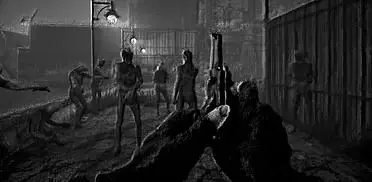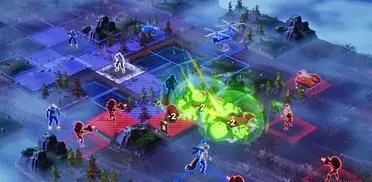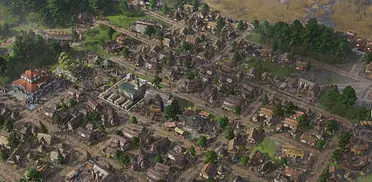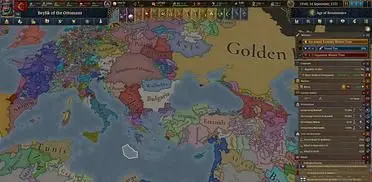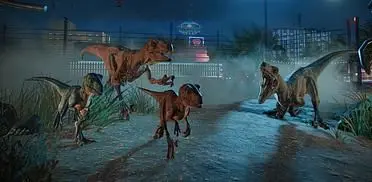Rome Total War is the long awaited historical strategy title from Creative Assembly and has been in development since the original total war game, Shogun. The improvements to Rome Total War are vast, indeed, to all features including the brilliant ancient setting, the fitting music, fantastic game play and stunning graphics.
Rome Total War can be summarised as a combination of two genres, real time strategy and turn based strategy. The campaign map, where the player actually directs their factions focus (decides what to build, where to attack, make diplomatic actions etc) is the turn based segment, however, when two armies meet on the campaign map they go into battle and Rome Total War delves into real time combat with seemingly spectacular graphics and game play. There are 2 turns in a year, one for summer and for one winter.
The graphic engine in Rome Total War is now completely 3D. Even strategy map will be viewed in 3D, which in previous total war games was 2D. This new strategy map has a camera much like in the battles, so you can pan the camera and zoom in on specific details such as bridges and marching armies. Movement on the campaign map has been changed too, instead of dragging and dropping an army, each army now has a movement bar, which decreases as you move which then replenishes when you end your turn.
In previous Total War games each region had its own single map, so there was a limited number of battle maps to fight on. Now in Rome Total War each land is divided into ‘squares’ and so each square is its own unique battle map. In battle maps it also pulls in adjacent ‘squares’ into the background for continuity. So for example if two armies meet in a plain with woods to the sides and in the distant north there’s a volcano, whilst your armies will be positioned on the plain you will be able to see forests on either side of the plain on which you fight and a puffing, smoking volcano in the distance.
The graphics in battles have undergone similar changes. Each soldier in a unit is now fully 3D so no longer a simple 2D sprite represented on the field. Result is that everything now looks much more realistic so you can really admire clashes between two charging armies of up to 10 thousand troops like never before. Thanks to the variation between different cultures in Rome Total War armies truly look different, even similar units like Peasants are unique amongst the cultures. Barbarian peasants stand taller than their Roman counter parts, with long hair and different style of clothing where as the Roman peasants have short hair and stand around sneezing away, noticeably frailer looking. Other units will look more daunting such as the legendary Spartans, completely armoured Cataphracts and heavily armoured Legions, but even these will pale in comparison to mighty War Elephants that will charge into dense formations crushing people and throwing them high into the air with their tusks.
All of these amazing on-screen fighting goes in well with the brilliant music to accompany Rome Total War, it’s easiest to describe the music style as reminiscent of Gladiator, and it truly is. The music fits each distinct culture very well and I’m sure you’ll agree if you have had the fortune of watching Time Commanders (check our forums for the videos), that the music is entirely suitable for the ancient theme and changes well to fit the pace of battles. The sound is similarly brilliant, you can hear the shouts and screams when two armies make impact, you can hear the sound of arrows, javelins and pilums raining down on troops and before battle, your generals will even give motivating speeches for your troops. These speeches will be different according to your situation, whether your general is cowardly, to the opponent your fighting, how big your armies are and the terrain on which you're to do battle on.
On the note of different civilisations, there will be in total 20 different ones, but only 6 different cultures, such as Roman, Greek, Eastern, Barbarian etc, and of these 20 factions 11 will be playable, after you unlock them using one of three different Roman factions in the main campaign which starts around 300BC and ends approximately 14AD. The Roman factions will consist of the house of Julii, house of Scipii and house of Brutii. These Roman factions will all start in different places and will have to contend with an ancient version of the pope, the senate. The senate will assign objectives for each different Roman faction to spread the Roman frontier and bring prestige to Rome and it will subsequently reward the faction that bides by its will. However if the player goes on their own and conquers too much too quickly, the senate will panic and try its best to diminish your power, after all they have good reason to fear you as your main object as the Romans is to hold the city of Rome for 20 years and become Imperator.
Each civilisation has its own unique benefits both strategically and in battle. The barbarians of the north have very fertile territory and so can field a lot of units quickly where as the Romans have to spend longer training their troops and will be much more careful in battle as it will take longer to replace lost troops. However the Romans are much better at ruling conquered people and will have what will be arguably the best heavy infantry in the game, the famous Legions. These will be a real killing machines and when working as a team they will be worth much more than their numbers. Similarly, the Greeks will also feature very good heavy infantry in the form of the Hoplites. Mighty Carthage to the south will not have such a broad range of troops to train and so will have to rely on mercenaries more. However the troops they can train will be very good shock troops, such as magnificent War Elephants. Whilst the eastern civilisations wont have as great heavy infantry as western civilisations they make up for this with brilliant cavalry and superb archers. Combination of both will wear down slow moving heavy infantry. Archers first and then ripping them to shreds with cavalry.
The way you recruit soldiers and animals of war, is to assign a certain unit in a city to be trained. However the units you can train depends on the structures that particular city has and also its population, because training units now takes a bit out of the population. You can retire units that might become obsolete to increase their population level and further progress.
Not only have the graphics and setting undergone drastic changes, but also Diplomacy is now promised to be much more detailed and versatile, allowing players to create complex arrangements. If your powerful enough you can treat other smaller nations as vassals, making outrageous demands with threats of dire consequences. Its good to be ruthless in Rome Total War.
Siege warfare has also had a makeover, no longer do you have to kill all defenders to capture a castle, instead you have to capture a cities town centre and so defenders would be wise to utilise choke points to make urban fighting tougher for the attacker. Also you’ll now be able to station defenders actually on the walls, however if the walls should happen to be undermined due to sapping or hit repeatedly from siege equipment, the wall will come tumbling down with soldiers. Interestingly, the city in the siege will be a direct representation of how it is, so if you built a coliseum, then that same coliseum will be visible when that city is besieged. Also, buildings can be destroyed in sieges in which the attacker if they win, or the defender if they survive, will have to rebuild from scratch, so sieges don’t always have to be about actually ‘winning’ you could just be destroying the enemies capacity to wage war by demolishing their major cities.
Off course the battles in Rome Total War would fall far short of the mark if the AI weren’t similarly improved. The AI is now much more adaptable to players strategy and tactics, on both the strategy map and in battle. The enemy will utilised tactics respective for its own culture. So if its Barbarians, there will be huge charges for which individual soldiers can earn glory and pincer movements in attempts to surround whole enemy formations, whilst utilising units to increase morale and decrease that of the enemies, where as the disciplined ranks of the Legionaries will keep a steady line, work as a team and refuse flanks when necessary and march ahead to achieve victory. However at a unit level, if their buddies around them are falling left right and centre, they will run to save their own skins, but also if units feel unprotected, such as if they are exposed with no protection at the flanks they will panic and break quickly if confronted by the enemy, also if a unit of archers sees charging cavalry heading for them, they wont be around for the cavalry to smash into them, instead they’ll be running out of the way, or at least try to. But its not just unit behaviour and battle tactics that has been improved. The player can now assign the AI to take control of whole armies if you don’t feel up to it but, if fighting is more your game and you don’t want to concentrate on micromanaging your nations economy, you can have the AI assigned to automate whole segments of the economy leaving you more time to do what you want.
Reading all this, you may get the impression that Rome Total War must be very complicated, but if you’ve had experience with previous total war incarnations you will realise that everything is done with simple clicks of the mouse and the occasional use of hotkeys. The Camera has undergone a few changes, you strafe the camera with left or right on the keyboard or moving the mouse cursor to the edge of the screen. You can rotate the camera by holding down a mouse button and moving the mouse. So from assigning what towns to build what, to demolishing cities in sieges to commanding thousands of troops to charge into the enemy, it’s all down to the mouse.To make things even easier for players, there will be an advisor that will appear in the upper left hand corner of the screen telling you what certain things do and the effects they will have. Of course if you feel you are able to play without an advisor popping up you can simply turn it of as it is completely optional.
Other things noteworthy about Rome Total War is that there will be important historical events within the timeline of Rome Total war. Such as the Marian reforms for the Roman army which will presumably occur sometime in the early 1st century BC in which the Roman army changed. So legions will no longer consisted of Hastati, Princeps and Triarri but rather, more famous and recognisable post marian reformed legionaries, complete with Lorica Hamata, Scutum and Gladius and able to form the well known testudo formation to protect themselves against missile attacks in siege warfare.
Also historical characters will make an appearance for the first time in the Total War series, for example the famous inventor Archimedes who helped defend a besieged Syracuse will be available to the player. Also not only will there be historical events and individuals, but there are a number of historical battles for the player to choose from a map editor and even a AI script editor and ‘unit dresser’ where the player can design completely new units.
Also one will also have to keep an eye on the status of their family tree, because your best generals will be your heirs so it may be worthwhile using them in battle to gain valuable skills, instead of earning negative skills much like the vice and virtues in Medieval Total war if they sit in a town doing nothing. The amount of heirs you have in your family tree will affect how fast you are able to expand the borders and power of your respective faction, also new to Rome Total War. But you will actually be able to ‘select’ your heir to choose the best one, so make sure they stay alive.
From reading this preview you can begin to understand why Rome Total War is easily one of the most anticipated games poised to come out 2004. It will also feature multiplayer and a selection of historical campaigns to choose from, such as Spartacus revolt. On top of this, Rome Total War will also come bundled with around 10 historical battles and a huge campaign map, recreating Ancient Europe which will take approximately 50 hours to complete. But you may also panic and think that you’ll need a top of the line PC just to run Rome Total War. But don’t. A mid-spec machine (800 MHZ, 256 Ram, 64 MB GeForce4 MX card) should be able to run Rome Total War quite well.






